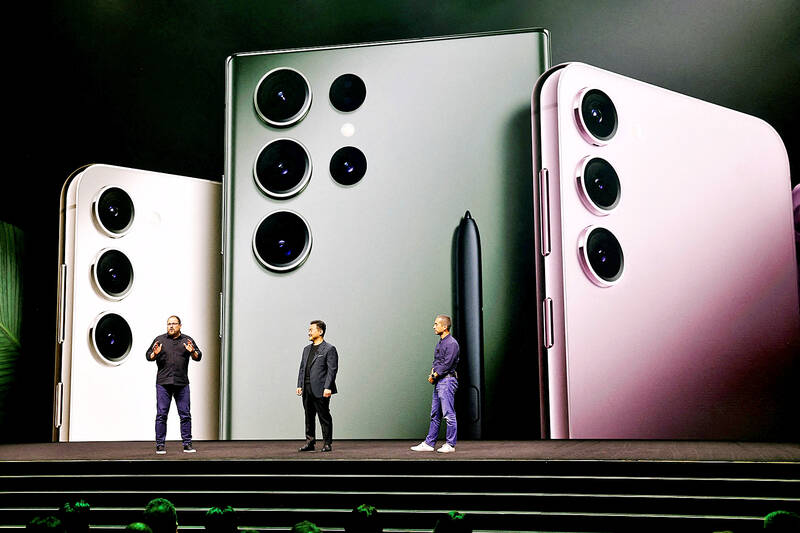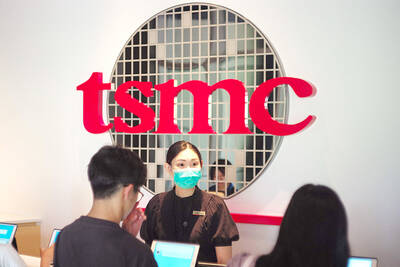Qualcomm Inc, the largest maker of smartphone processors, reported quarterly earnings that showed signs of success for the chipmaker’s push into new businesses like computers and vehicles, an effort that helped mitigate the impact of a prolonged slump in mobile-handset sales.
In fiscal first quarter, which ended on Dec. 25, Qualcomm said revenue fell 12 percent to US$9.46 billion, missing analysts’ average projection. While handset-
related sales slumped 18 percent to US$5.75 billion, that was higher than some analysts had predicted and topped an average estimate of US$5.25 billion.

Photo: Reuters
Automotive sales jumped 58 percent from a year earlier to US$456 million. Connected devices revenue rose 7 percent to US$1.68 billion.
Under CEO Cristiano Amon, the company has accelerated its effort to sell chips for different industries, trying to lessen its dependence on the smartphone market. Still, Qualcomm’s sales decline and a disappointing outlook for the current period indicate that demand for mobile phones remains hamstrung by sluggish consumer spending on big-ticket items in an unsteady economy.
Qualcomm expects customers, who have accumulated large stockpiles of unused components, to wrap up their inventory reduction efforts around the middle of the year, returning to more predictable order patterns in the second half.
China’s lifting of COVID-19-
related restrictions on its population should begin to help consumer demand in the world’s biggest market for phones, executives said on a conference call with analysts.
“There is optimism that the second half could be better,” Amon said. “Beyond 2023 for Qualcomm we see many of our growth initiatives gaining scale.”
San Diego-based Qualcomm’s main product is the processor that runs many of the world’s best-known handsets. It also sells the modem chips that connect the iPhone to high-speed data networks. A chunk of Qualcomm’s profit also comes from licensing the fundamental technology that underpins all modern mobile networks — fees that phone makers pay whether they use Qualcomm-branded chips or not.
The semiconductor maker has avoided some of the worst of the recent slowdown by winning more business at Samsung Electronics Co, which is using Qualcomm’s Snapdragon processors more in its Galaxy phones. Apple has also continued to buy from Qualcomm longer than projected, as it continues to work on developing its own replacement chips.
The company posted adjusted profit for the first quarter of US$2.37 a share. Analysts on average were looking for US$2.35.
Revenue would be US$8.7 billion to US$9.5 billion in the fiscal second quarter, Qualcomm said in a statement on Thursday, compared with analysts’ estimates of US$9.58 billion. Excluding certain items, profit in the current period will be as low as US$2.05 a share, while the average projection was for per-share profit of US$2.29.

Taiwan Transport and Storage Corp (TTS, 台灣通運倉儲) yesterday unveiled its first electric tractor unit — manufactured by Volvo Trucks — in a ceremony in Taipei, and said the unit would soon be used to transport cement produced by Taiwan Cement Corp (TCC, 台灣水泥). Both TTS and TCC belong to TCC International Holdings Ltd (台泥國際集團). With the electric tractor unit, the Taipei-based cement firm would become the first in Taiwan to use electric vehicles to transport construction materials. TTS chairman Koo Kung-yi (辜公怡), Volvo Trucks vice president of sales and marketing Johan Selven, TCC president Roman Cheng (程耀輝) and Taikoo Motors Group

Among the rows of vibrators, rubber torsos and leather harnesses at a Chinese sex toys exhibition in Shanghai this weekend, the beginnings of an artificial intelligence (AI)-driven shift in the industry quietly pulsed. China manufactures about 70 percent of the world’s sex toys, most of it the “hardware” on display at the fair — whether that be technicolor tentacled dildos or hyper-realistic personalized silicone dolls. Yet smart toys have been rising in popularity for some time. Many major European and US brands already offer tech-enhanced products that can enable long-distance love, monitor well-being and even bring people one step closer to

RECORD-BREAKING: TSMC’s net profit last quarter beat market expectations by expanding 8.9% and it was the best first-quarter profit in the chipmaker’s history Taiwan Semiconductor Manufacturing Co (TSMC, 台積電), which counts Nvidia Corp as a key customer, yesterday said that artificial intelligence (AI) server chip revenue is set to more than double this year from last year amid rising demand. The chipmaker expects the growth momentum to continue in the next five years with an annual compound growth rate of 50 percent, TSMC chief executive officer C.C. Wei (魏哲家) told investors yesterday. By 2028, AI chips’ contribution to revenue would climb to about 20 percent from a percentage in the low teens, Wei said. “Almost all the AI innovators are working with TSMC to address the

Malaysia’s leader yesterday announced plans to build a massive semiconductor design park, aiming to boost the Southeast Asian nation’s role in the global chip industry. A prominent player in the semiconductor industry for decades, Malaysia accounts for an estimated 13 percent of global back-end manufacturing, according to German tech giant Bosch. Now it wants to go beyond production and emerge as a chip design powerhouse too, Malaysian Prime Minister Anwar Ibrahim said. “I am pleased to announce the largest IC (integrated circuit) Design Park in Southeast Asia, that will house world-class anchor tenants and collaborate with global companies such as Arm [Holdings PLC],”